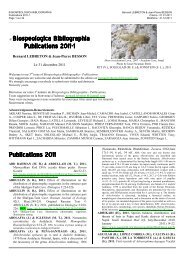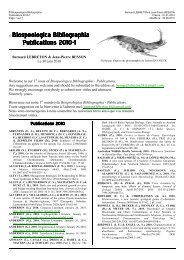Biospeologica Bibliographia Publications 2010-2
Biospeologica Bibliographia Publications 2010-2
Biospeologica Bibliographia Publications 2010-2
Create successful ePaper yourself
Turn your PDF publications into a flip-book with our unique Google optimized e-Paper software.
© <strong>Biospeologica</strong> <strong>Bibliographia</strong><br />
<strong>Publications</strong> <strong>2010</strong>-1<br />
Page 40 sur 116<br />
that as well includes reserving sites by giving them an official status of<br />
protected objects, has been started.<br />
GOFFREDO (S.), GASPARINI (G.), MARCONI (G.),<br />
PUTIGNANO (M. T.), PAZZINI (C.) & ZACCANTI<br />
(F.), <strong>2010</strong>. Gonochorism and planula brooding in the<br />
Mediterranean endemic orange coral Astroides calycularis<br />
(Scleractinia: Dendrophylliidae). Morphological aspects of<br />
gametogenesis and ontogenesis. Marine Biology Research<br />
6(5):421-436. DOI:<br />
http://dx.doi.org/10.1080/17451000903428488. BL: Cf p.<br />
422-423, " Astroides calycularis is found at depths of 0-50 m (Rossi,<br />
1971), but is typically found in the shallow infralittoral (0-15 m depth),<br />
on vertical walls or inside caves (Kruzic & al., 2002)".<br />
GOLOVATCH (S. I.), GEOFFROY (J.-J.) & MAURIÈS<br />
(J.-P.), <strong>2010</strong>. Review of the Millipede Genus Pacidesmus<br />
Golovatch, 1991, with Descriptions of Three New Species<br />
from Caves in Southern China (Diplopoda: Polydesmida:<br />
Polydesmidae). Tropical Natural History 10(2,<br />
October):159-169. ABS: The small Southeast to East Asian genus<br />
Pacidesmus currently encompasses seven species, all keyed and mapped,<br />
including three new from caves in Guangxi Province, China: P. tiani n.<br />
sp., P. bedosae n. sp. and P. armatus n. sp. All six congeners from<br />
southern China have only been found in caves, all likely representing<br />
troglobites, whereas the sole epigean species is known from a highmontane<br />
forest in northern Thailand. Such a vast disjunction is certainly<br />
due to undercollecting, also meaning a far more diverse fauna of<br />
Pacidesmus to actually exist. KW: Diplopoda, Pacidesmus, new species,<br />
key, cave, China.<br />
http://www.biology.sc.chula.ac.th/TNH/vol10%20no2.html<br />
GOLOVATCH (S. I.), MIKHALJOVA (E. V.), KORSÓS<br />
(Z.) & CHANG (H.-W.), <strong>2010</strong>. The Millipede Family<br />
Haplodesmidae (Diplopoda, Polydesmida) Recorded in<br />
Taiwan for the First Time, with the Description of a New<br />
Species. Tropical Natural History 10(1, April):27-36.<br />
http://www.biology.sc.chula.ac.th/TNH/vol10%20no1.html<br />
GONZÁLEZ-GORDILLO (J. I.), ANGER (K.) &<br />
SCHUBART (C. D.), <strong>2010</strong>. Morphology of the larval and<br />
first juvenile stages of two Jamaican endemic Crab species<br />
with abbreviated development, Sesarma windsor and<br />
Metopaulias depressus (Decapoda: Brachyura:<br />
Sesarmidae). Journal of Crustacean Biology 30(1,<br />
February):101-121. DOI: http://dx.doi.org/10.1651/08-<br />
3110.1. ABS: The complete larval development and the morphology of<br />
the first juvenile stages of two freshwater-breeding crab species endemic<br />
to Jamaica are described and illustrated in detail in the present paper. One<br />
of these species, Sesarma windsor, lives in and near caves in the karst<br />
regions of central western Jamaica, whereas the second species,<br />
Metopaulias depressus, occurs sympatrically but with a wider range in<br />
western and central Jamaica in water-filled leaf axils of bromeliads. Even<br />
if these species are placed in separate genera, they are extant<br />
representatives of the same adaptive radiation that resulted in at least ten<br />
Jamaican endemic crab species thriving in different land-locked habitats.<br />
Consequently, larval morphologies of the two species are very similar,<br />
but conspicuously different from the developmental patterns in their<br />
marine relatives. Both species display an abbreviated mode of<br />
development, showing morphological reductions in some features and<br />
pre-displacement in the expression of several others. Both species pass<br />
through two non-feeding zoeal stages, after which S. windsor moults to a<br />
facultatively lecithotrophic megalopa. In contrast, M. depressus directly<br />
moults from the zoea II to a juvenile stage (also facultatively<br />
lecithotrophic) that shows a mixture of juvenile and vestigial larval<br />
characters, such as a partly folded pleon, but no longer larval traits such<br />
as natatory pleopods. This represents the first record of larval<br />
development with no megalopal stage for Sesarmidae. A closely related<br />
species from mangroves in the Caribbean and northeastern South<br />
America, Sesarma curacaoense, shows a reduction in larval development,<br />
but with different morphological characteristics. We here discuss whether<br />
this could be a shared ontogenetic character or the consequence of<br />
convergent evolution. KW: Bromeliads, fresh water, larval development,<br />
mangroves, Thoracotremata.<br />
Bernard LEBRETON & Jean-Pierre BESSON<br />
Créé le : 01.01.<strong>2010</strong><br />
Modifié le : 30.06.<strong>2010</strong><br />
GOODMAN (S. M.), MAMINIRINA (C. P.), BRADMAN<br />
(H. M.), CHRISTIDIS (L.) & APPLETON (B. R.),<br />
<strong>2010</strong>. Patterns of morphological and genetic variation in<br />
the endemic Malagasy bat Miniopterus gleni (Chiroptera:<br />
Miniopteridae), with the description of a new species, M.<br />
griffithsi. Journal of Zoological Systematics and<br />
Evolutionary Research 48(1, February):75-86. DOI:<br />
http://dx.doi.org/10.1111/j.1439-0469.2009.00524.x. ABS:<br />
Over the past decade, major advances have been made concerning the<br />
systematics and species diversity of Malagasy bats, largely based on<br />
specimens collected during inventories and associated morphological and<br />
molecular genetic studies. Herein we describe a new species of endemic<br />
bat from southern Madagascar, Miniopterus griffithsi sp. n., which is the<br />
sister taxa to Miniopterus gleni, a taxon described in 1995 (holotype from<br />
Sarodrano, just north of the Onilahy River in the southwest). Based on<br />
current information, M. griffithsi is found in the sub-arid bioclimatic<br />
zone, south of the Onilahy River, and M. gleni occurs in a variety of<br />
different bioclimatic zones, north of the Onilahy River to the northern<br />
portion of the island and on the near shore island of Ile Sainte Marie. The<br />
realization that M. griffithsi was a separate entity was first based on<br />
phylogeographic studies of the M. gleni complex. Comparisons using 397<br />
bp of mitochondrial cytochrome b found a divergence of 1.2% within<br />
animals occurring across much of Madagascar north of the Onilahy<br />
River, 0.07% in those south of the Onilahy River, and 7.4% in<br />
populations separated by this river. Subsequently, morphological<br />
characters were identified that supported the specific separation of<br />
populations occurring south (M. griffithsi) and north of the Onilahy River<br />
(M. gleni), which include tragus shape, pelage coloration, and skull<br />
proportions. KW: Miniopteridae, Miniopterus, Miniopterus gleni,<br />
Miniopterus griffithsi sp. n. - Madagascar, morphological variation,<br />
phylogeography. RÉS: Au cours de la dernière décennie, d'importants<br />
progrès ont été accomplis en ce qui concerne la compréhension de la<br />
systématique et de la diversité des espèces de chauves-souris malgaches,<br />
en grande partie basée sur des spécimens collectés au cours des<br />
inventaires ainsi que sur les études morphologiques et génétiques<br />
moléculaires associées. Nous décrivons ici une nouvelle espèce de<br />
chauve-souris du sud de Madagascar, Miniopterus griffithsi sp. n., qui est<br />
la sœur de M. gleni, un taxon décrit en 1995 (holotype de Sarodrano, juste<br />
au nord de la rivière Onilahy). Sur la base des informations actuelles, M.<br />
griffithsi se trouve dans la zone bioclimatique sub-aride de l'île, au sud de<br />
la rivière Onilahy, et M. gleni se produit dans une variété de zones<br />
bioclimatiques, du nord de la rivière Onilahy jusqu'au nord de l'île et sur<br />
l'Ile Sainte Marie. Les deux espèces semblent utiliser des grottes et des<br />
abris sous roche comme gîtes diurnes. Le fait que M. griffithsi soit une<br />
entité distincte est fondé sur des études phylogéographiques du complexe<br />
M. gleni. Les comparaisons avec les 397 bp du mitochondrial cytochrome<br />
b montre une divergence de 1,2% dans les animaux qui se produisent<br />
dans la majeure partie de Madagascar au nord de la rivière Onilahy,<br />
0,07% dans celles au sud de la rivière Onilahy et 7,4% dans les<br />
populations séparées par cette rivière. Par la suite des caractères<br />
morphologiques ont été identifiés, comprenant la forme du tragus, la<br />
coloration du pelage et les proportions du crâne, soutenant ainsi la<br />
séparation des populations qui se produisent au sud (M. griffithsi) et au<br />
nord de la rivière Onilahy (M. gleni). La zone d'occupation connue pour<br />
M. griffithsi est d'environ 740 km², mais ce n'est certainement pas<br />
représentatif de la distribution de cette espèce.<br />
GOTTSTEIN (S.), ŽGANEC (K.), KRNJEVIĆ (V. C.) &<br />
POPIJAČ (A.), <strong>2010</strong>. Life history traits of the epigean<br />
populations of Niphargus dalmatinus (Crustacea:<br />
Amphipoda) along the Cetina River, Croatia:23-24. In:<br />
20 th International Conference on Subterranean Biology,<br />
Postojna, Slovenia, 29 August-3 September <strong>2010</strong>, ICSB<br />
<strong>2010</strong> Abstract Book, edited by: Ajda MOŠKRIČ and Peter<br />
TRONTELJ, ISBN 978-961-269-286-5. ABS: Very little is<br />
known about the epigean niphargid autecology. The aim of this study was<br />
to establish the life history traits of the endemic amphipod Niphargus<br />
dalmatinus, which regularly inhabits springs, epigean streams and rivers<br />
in Middle Dalmatia. Three replicate samples were collected once a month<br />
with benthos net in the period from August 2004 to August 2005 at ten<br />
study sites located in the upper, middle and lower reaches of the Cetina<br />
River and its tributaries. The highest population density of the species<br />
was recorded on two study sites in hypocrenal zone, where the mean<br />
water temperature reached 9.7°C with the narrow range of 7.3-12.5°C.





